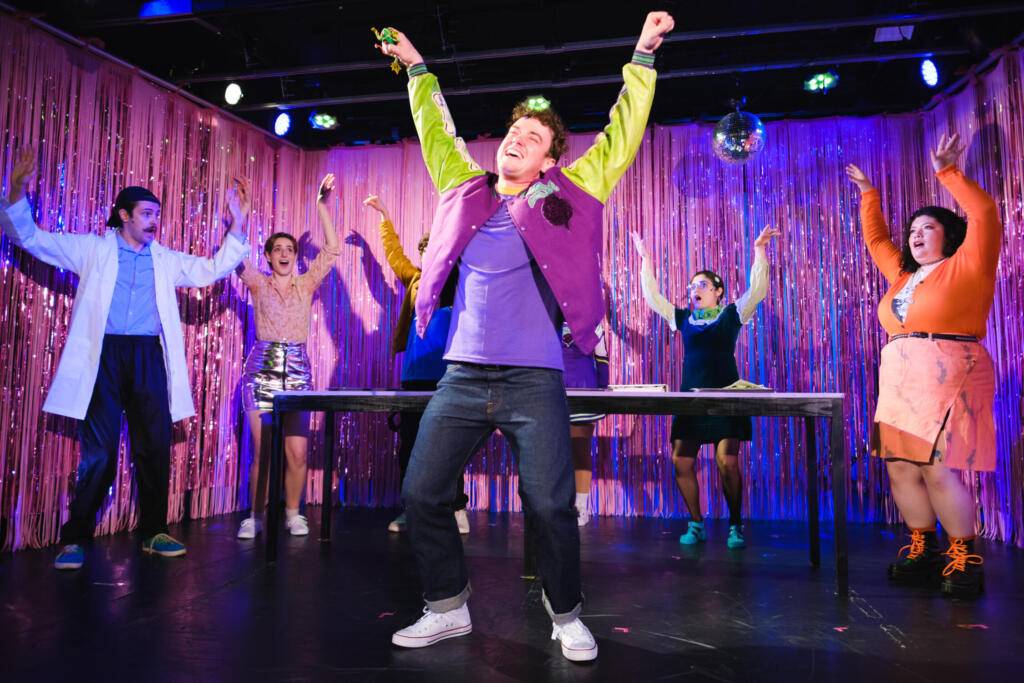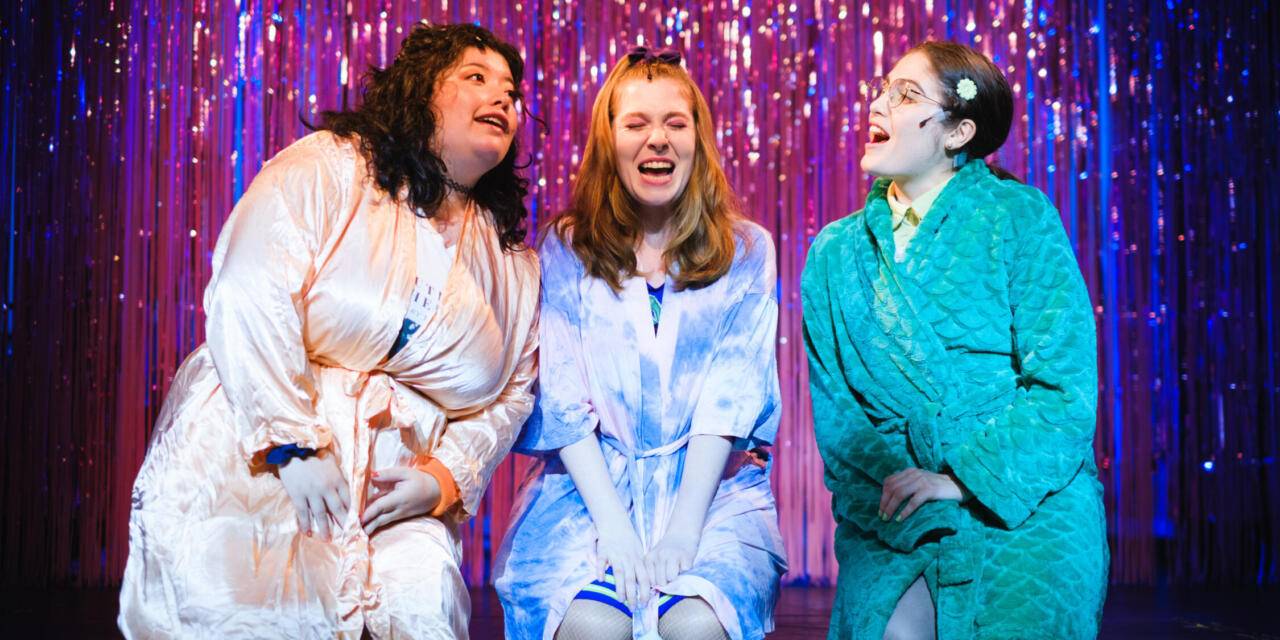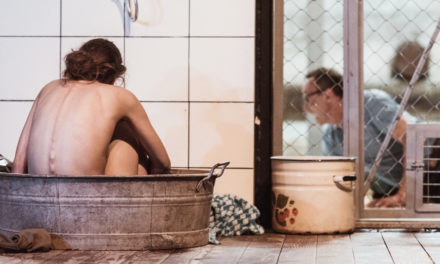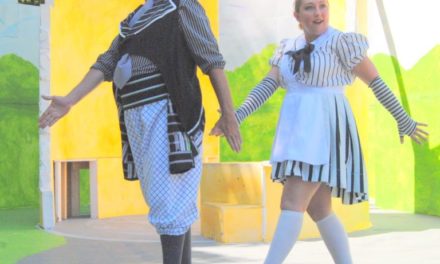Upon one’s first step into the Players Theatre, one knows exactly what they’re in for. The stage is dressed in metallic pink streamers and backlit with subtle eerie green; Kesha’s “Cannibal” blasts from the speakers; and the proffered drinks are titled after the undead. Campy nostalgia oozes from every corner. And what is promised is precisely what’s delivered.
The easiest way to describe Annie Pulsipher and Alex Petti’s The Trouble with Dead Boyfriends is through its amalgamation: the musical finds root and comparison in Heathers, Zombie Prom, Twilight, Monty Python, Grease, and Buffy the Vampire Slayer, a combination in which the show attempts feminist subversion. Best friends Madison (Zoe Dean), Stella (Heather Sawyer), and Grace (Alia Cuadros-Contreras) enter high school determined to have the boyfriends of their dreams. To ensure that happens, the three enact a centuries-old spell to summon their romances. The girls get more than they bargained for in the forms vampiric, ghostly, and zombified.
These subsequent boyfriends are the epitome of classical tropes, providing easily-identifiable stories for the audience to grasp onto. Vampire Lucian (Will Einbinder) becomes Sid Vicious; ghost Silence (Hagan Oliveras) is Heathcliff; zombie Zachary (Patrick Voss Davis) appears as Danny Zuko. Toxicity flourishes in tandem with each archetype: the stolen identity of the vampiric, the possession of the ghost, the aggression of the zombie. Through the girls’ relationships with these monsters, the audience is provided with commentary on consent, domestic violence, verbal abuse, assault, and the justification women trapped in these situations offer themselves. It’s a rather poignant line to draw. To do it all with a darkly comic grin adds a layer of challenge.
Largely, the structure of The Trouble with Dead Boyfriends rises to the task. Fun caricatures of pop culture icons provide laughter, undercut by the bruises on the women’s bodies. The internalization of abusive relationships turns physical, seen in Maddie’s purple neck, Grace’s stolen words, Stella’s quietude of esteem. “Monster” becomes not just a word in sepia-toned film, but a literality of space. The direct parallels between abuse, cinema, literature, and reality are truly wonderful.

Unfortunately, they are also not as strong as one would like them to be. The show is not complete yet, in all fairness, but the dramatic and directorial structure has not reached its crux. The show is fun. It harnesses bright cartoon color theory (costume design by Olivia Vaughn Hern) and clever overhead projector puns (crafted by Stephen M. Eckert) with delightful combination, transporting the audience to a time of Nickelodeon and Cartoon Network. The songs are utter bops, the minimal dancing full of verve and vigor; the harmonies are beautiful, especially when our trio of women sings together. The show is fun. It’s fun.
That can be powerful (e.g. Fleabag, wherein Phoebe Waller-Bridge disarms with comedy). However, the lack of consistency and balance within The Trouble with Dead Boyfriends makes what could be truly stunning a little underwhelming.
The temporality of the piece felt a touch out-of-tune, uncertain if it wanted to ground in the 1980s or the 2000s. Though I acknowledge that may be a choice of circuitous highlight, I felt uncertain of the rules of the world. That contributed to further character confusion. I had no idea why these three young women were friends, or why they would get along in the first place: their opposites-attract natures provided far more conflict than love. I didn’t understand where the supernatural lay in this world; I did not realize until Act II that vampires, werewolves, zombies, and the like were an accepted fact of the environment. Moments of fourth wall breaks were scattered throughout, and I was never certain if this was an immersive piece or not. Vaudevillian style threaded its way through, unsure of camp or realism. There needed to be a better balance of time and happenstance between Acts I and II, the innovation of subversion could be leaned into far more, and I would’ve loved longer finales.
That may sound like a lambasting. I don’t desire it to. I had a wonderful time at this show, and I believe in its future power and affect. It knows its atmosphere and what it wants to accomplish. Now it just has to get there.
It’s worth pointing out that this production did reach that affect in its two ensemble members. Stephanie Hawkins and Patrick Swailes Caldwell, playing a myriad of filler characters, were truly the highlight of the evening. The duo’s versatility brought a remarkable vivacity to the musical; they strode the line between hilarity and solemnity with ease. I knew that whenever they walked onstage, something beautiful would happen.
In short, I will be thrilled to see how this show develops. It holds so much promise. It is timely and needed. I am greatly looking forward to its next production.
For more information on The Trouble with Dead Boyfriends, click here.
This post was written by the author in their personal capacity.The opinions expressed in this article are the author’s own and do not reflect the view of The Theatre Times, their staff or collaborators.
This post was written by Rhiannon Ling.
The views expressed here belong to the author and do not necessarily reflect our views and opinions.


















